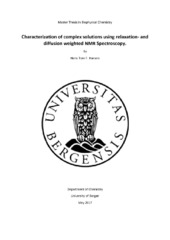| dc.description.abstract | The need for a sustainable replacement to the conventional fossil fuels is required. Biooils is a potential replacement. The biooil analyzed in this thesis is made from lignin, which is a by-product of paper production. This process is called Lignin-to-Liquid. A method to efficiently examine the oils with respect to molecular size distribution is required. In this thesis, high field relaxation and diffusion measurements are performed on diluted and non-diluted samples of crude oils. The crude oils have previously been examined with true boiling point distillation or compositional analysis. The same experiments are also performed on a biooil with unknown composition in attempt to characterize it with respect to molecular size distribution. Spectral relaxation and diffusion measurements show that the chemical differences and more electronegative nature of the biooils causes aggregation at lower concentration than the crude oils. From the spectral diffusion and relaxation measurements no differences in molecular sizes was seen for the crude oils. The results from the T1-T2 correlation experiments showed a higher T1/T2 ratio of the lowest concentration sample of all the crude oils. Spectral relaxation measurements of the non-diluted oils showed minor variation of T1 relaxation times. High variation was seen in the T2 relaxation times and the shortest T2 relaxation times were found in the most electronegative region of the aliphatic region, as well as in the most electronegative part of the aromatic region. The T1-T2 correlation relaxation measurements replicated the spectral relaxation measurements for the non-diluted samples, meaning it is a viable time-saving option for non-diluted samples. Diffusion measurements of the non-diluted samples showed low variation, however when normalizing with the viscosity results were the same as previous analysis with respect to molecular size distribution. In the analysis of the diluted samples the biooil is very different from the crude oils due to it aggregating at lower concentrations. The difference is made clearer due to the viscosity difference of the solvents. In the analysis of the non-diluted samples the biooil appear to be quite equal to the Grane crude with respect to molecular size distribution, although it is chemically different. | en_US |
